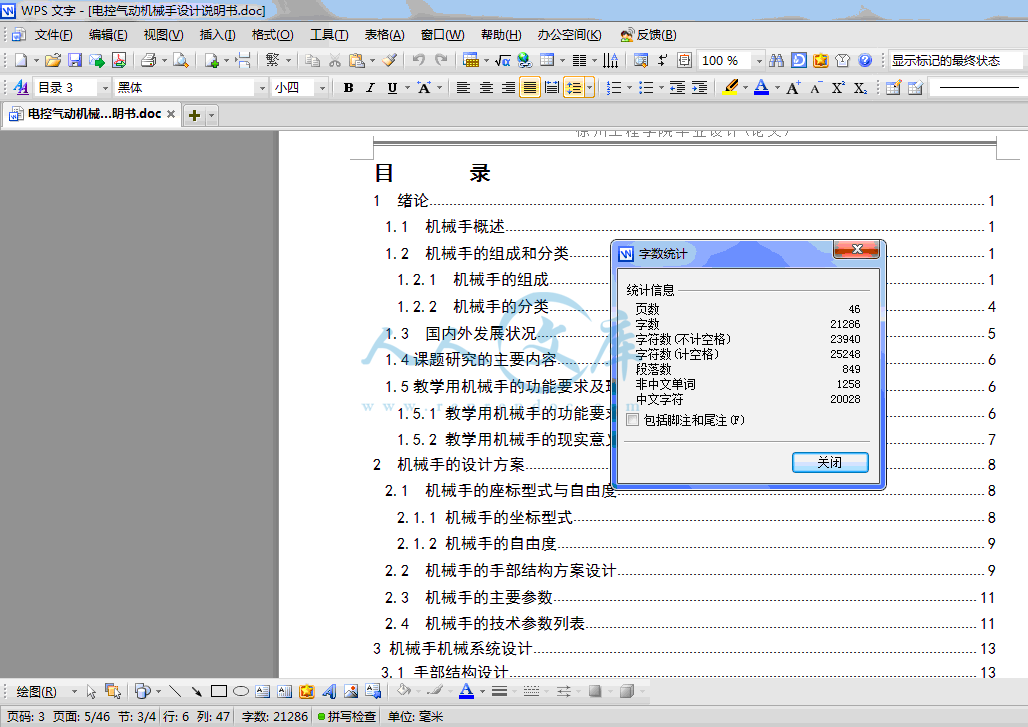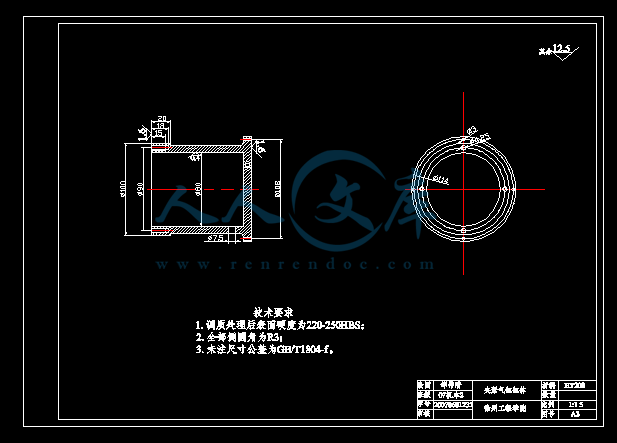电控气动机械手设计
46页 21000字数+说明书+6张CAD图纸【详情如下】
外文翻译--气动肌肉伺服并联机构位姿自适应鲁棒控制的研究.doc
夹紧气缸缸体.dwg
手臂伸缩手腕回转.dwg
手臂升降回转.dwg
手部.dwg
教学型搬运机械手的设计(气动机械手的设计).doc
电路图.dwg
装配图.dwg








目 录
1 绪论1
1.1 机械手概述1
1.2 机械手的组成和分类1
1.2.1 机械手的组成1
1.2.2 机械手的分类4
1.3 国内外发展状况5
1.4课题研究的主要内容6
1.5教学用机械手的功能要求及现实意义6
1.5.1 教学用机械手的功能要求6
1.5.2 教学用机械手的现实意义7
2 机械手的设计方案8
2.1 机械手的座标型式与自由度8
2.1.1 机械手的坐标型式8
2.1.2 机械手的自由度9
2.2 机械手的手部结构方案设计9
2.3 机械手的主要参数11
2.4 机械手的技术参数列表11
3 机械手机械系统设计13
3.1 手部结构设计13
3.1.1 设计时考虑的几个问题13
3.1.2手爪夹持装置的机构选型13
3.1.3 手部夹紧气缸的设计15
3.2手腕结构设计19
3.2.1 手腕的自由度19
3.2.2 手腕的驱动力矩的计算19
3.3手臂结构设计23
3.3.1手臂伸缩与手腕回转部分23
3.3.2手臂升降和回转部分26
3.3.3手臂升降气缸的设计26
3.3.4手臂回转缸体的设计29
4机械手气压系统的设计31
4.1气压传动系统工作原理图31
4.2气动元件介绍31
5 机械手控制系统设计35
5.1 控制系统的结构分类35
5.2 控制方式35
5.3机械手的控制36
6 结论38
7致谢39
参考文献40
1 绪论
1.1 机械手概述
机器人由操作机(机械本体)、控制器、伺服驱动系统和检测传感装置构成,是一种仿人操作,自动控制、可重复编程、能在三维空间完成各种作业的机电一体化自动化生产设备。特别适合于多品种、变批量的柔性生产。它对稳定、提高产品质量,提高生产效率,改善劳动条件和产品的快速更新换代起着十分重要的作用。
机器人技术是综合了计算机、控制论、机构学、信息和传感技术、人工智能、仿生学等多学科而形成的高新技术,是当代研究十分活跃,应用日益广泛的领域。机器人应用情况,是一个国家工业自动化水平的重要标志。
机器人并不是在简单意义上代替人工的劳动,而是综合了人的特长和机器特长的一种拟人的电子机械装置,既有人对环境状态的快速反应和分析判断能力,又有机器可长时间持续工作、精确度高、抗恶劣环境的能力,从某种意义上说它也是机器的进化过程产物,它是工业以及非产业界的重要生产和服务性设各,也是先进制造技术领域不可缺少的自动化设备。
机械手是模仿着人手的部分动作,按给定程序、轨迹和要求实现自动抓取、搬运或操作的自动机械装置。在工业生产中应用的机械手被称为“工业机械手”。生产中应用机械手可以提高生产的自动化水平和劳动生产率:可以减轻劳动强度、保证产品质量、实现安全生产;尤其在高温、高压、低温、低压、粉尘、易爆、有毒气体和放射性等恶劣的环境中,它代替人进行正常的工作,意义更为重大。因此,在机械加工、冲压、铸、锻、焊接、热处理、电镀、喷漆、装配以及轻工业、交通运输业等方面得到越来越广泛的引用。
机械手的结构形式开始比较简单,专用性较强,仅为某台机床的上下料装置,是附属于该机床的专用机械手。随着工业技术的发展,制成了能够独立的按程序控制实现重复操作,适用范围比较广的“程序控制通用机械手”,简称通用机械手。由于通用机械手能很快的改变工作程序,适应性较强,所以它在不断变换生产品种的中小批量生产中获得广泛的引用。
1.2 机械手的组成和分类
1.2.1 机械手的组成
机械手主要由执行机构、驱动系统、控制系统以及位置检测装置等所组成。各系统相互之间的关系如方框图1-1所示。
图1-1机械手的组成方框图
(一)执行机构
它包括手部、手腕、手臂和立柱等部件,有的还增设行走机构。
1、手部
即与物件接触的部件。由于与物件接触的形式不同,可分为夹持式和吸附式手部。夹持式手部由手指(或手爪) 和传力机构所构成。手指是与物件直接接触的构件,常用的手指运动形式有回转型和平移型。回转型手指结构简单,构件制造容易,故应用较广泛。平移型应用较少,其原因是结构比较复杂,但平移型手指夹持圆形零件时,工件直径变化不影响其轴心的位置,因此适宜夹持直径变化范围大的工件。
手指结构取决于被抓取物件的表面形状、被抓部位(是外廓或是内孔)和物件的重量及尺寸。常用的指形有平面的、V形面的和曲面的:手指有外夹式和内卡式;指数有双指式、多指式和双手双指式等。
而传力机构则通过手指产生夹紧力来完成夹放物件的任务。传力机构型式较常用的有:连杆式、凸轮式、齿轮齿条式、螺旋式和绳轮式等。
吸附式手部主要由吸盘等构成,它是靠吸附力(如吸盘内形成负压或产生电吸磁力)吸附物件,相应的吸附式手部有负压吸盘和电磁盘两类。
对于轻小片状零件、光滑薄板材料等,通常用负压吸盘吸料。造成负压的方式有气流负压式和真空泵式。
对于导磁性的环类和带孔的盘类零件,以及有网孔状的板料等,通常用电磁吸盘吸料。电磁吸盘的吸力由直流电磁铁和交流电磁铁产生。
用负压吸盘和电磁吸盘吸料,其吸盘的形状、数量、吸附力大小,根据被吸附的物件形状、尺寸和重量大小而定。
2、手腕
是连接手部和手臂的部件,并可用来调整被抓取物件的方位(即姿势)。
3、手臂
手臂是支承被抓物件、手部、手腕的重要部件。手臂的作用是带动手指去抓取物件,并按预定要求将其搬运到指定的位置。机械手的手臂通常由驱动手臂运动的部件(如油缸、气缸、齿轮齿条机构、连杆机构、螺旋机构和凸轮机构等)与驱动源(如液压、气压或电机等)相配合,以实现手臂的各种运动。
机械手的技术参数列表
一.用途:教学型机械手
二.设计技术参数:
1.抓重:10千克
2.自由度数:4个自由度
3.座标型式:圆柱型座标
4.最大工作半径:1000mm
5.手臂最大中心高:1380mm
6.手臂运动参数
伸缩行程400mm
伸缩速度50mm/s
升降行程200mm
升降速度50mm/s
回转范围00-2400
回转速度900/s
7.手腕运动参数
回转范围 00-1800
回转速度1800/s
8.定位精度:±0. 5mm
9.缓冲方式:液压缓冲器
10.传动方式:气压传动
11.控制方式:点位程序控制(采用单片机)
 川公网安备: 51019002004831号
川公网安备: 51019002004831号